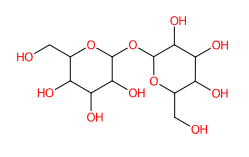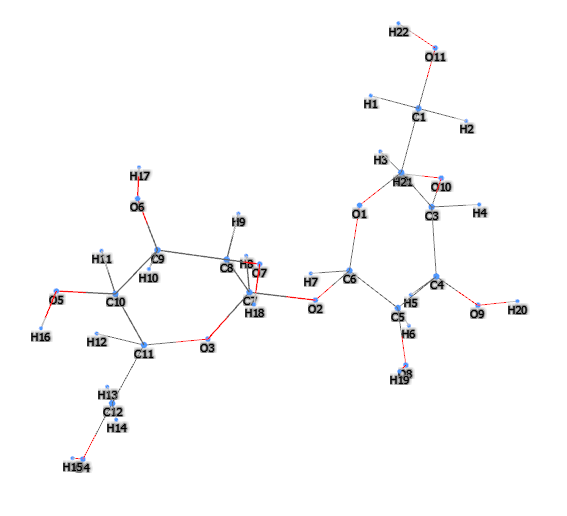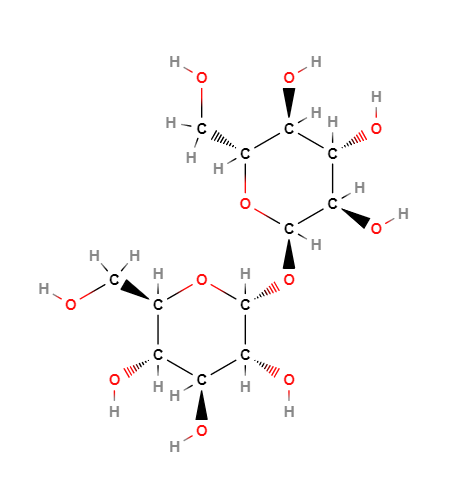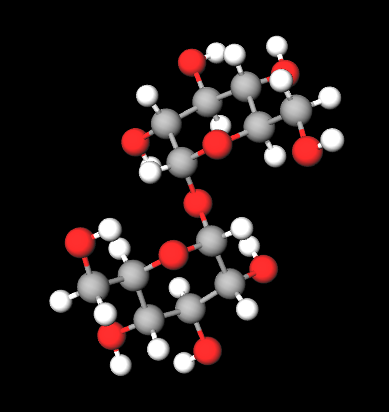| "Descrizione" by Whiz35 (11840 pt) | 2022-Dec-31 19:20 |
Review Consensus: 17 Rating: 8.5 Number of users: 2
| Evaluation | N. Experts | Evaluation | N. Experts |
|---|---|---|---|
| 1 | 6 | ||
| 2 | 7 | ||
| 3 | 8 | ||
| 4 | 9 | ||
| 5 | 10 |
Trehalose is a natural sugar consisting of two glucose molecules, a non-reducing disaccharide in which the two glucose molecules are linked together in an α,α-1,1-glycosidic bond. Discovered in 1832 by the German pharmacist Heinrich August Ludwig Wiggers in rye. The name trehalose was given by the French chemist Marcellin Pierre Eugène Berthelot in 1859 i an experiment on the non-reducing disaccharide Trehala manna.
It is found in all major groups of organisms except vertebrates with the function of transporting sugar and protecting against stress. Trehalose is present in Selaginella lepidophylla (Hook. & Grev.) and other primitive plants as well as in algae, mosses and ferns (Elbein , 1974; Kandler and Hopf, 1980). It is both a negative feedback regulator of sucrose levels, in a mechanism of optimal maintenance of sucrose levels, and functionally comparable to the insulin-glucagon system for regulating blood glucose levels (1).
It is an antioxidant widely distributed in Nature and has been isolated from certain species of bacteria, fungi, invertebrates and plants, which are capable of surviving in a dehydrated state for months or years and subsequently being revived after a few hours of being in contact with water. This disaccharide has many biotechnological applications, as its physicochemical properties allow it to be used to preserve foods, enzymes, vaccines, cells etc., in a dehydrated state at room temperature. One of the most striking findings a decade ago was the discovery of the genes involved in trehalose biosynthesis, present in a great number of organisms that do not accumulate trehalose to significant levels. In plants, this disaccharide has diverse functions and plays an essential role in various stages of development, for example in the formation of the embryo and in flowering. Trehalose also appears to be involved in the regulation of carbon metabolism and photosynthesis. Recently it has been discovered that this sugar plays an important role in plant-microorganism interactions (2).
It appears in the form of a white powder.

What it is used for and where
Synthetic, organic intermediate material.
Food
It is an important molecule for food applications. These applications include use as a food additive to increase sweetness (45% more than sugar) and promote preservation in freeze-drying. It has a high water-holding capacity, prevents starch ageing and protein denaturation. Maintains the stability and tightness of plant and meat tissues It is incorporated in dry and processed foods, confectionery, baked goods, ice cream, condiments.

Medical
Trehalose is also included in antibody preparations for stabilisation during freezing or drying. However, despite all its uses, the direct physiological roles of trehalose remain unclear (3).
Used in cryopreservation of human cells, biopharmaceutical preservation of labile protein drugs.
Cosmetics
In cosmetic products, it is used as a moisturiser and antioxidant to maintain cell viability by protecting epidermal cells and imparting elasticity to the skin. It also has the function of protecting against oxygen radical damage, protecting proteins and membranes, and regulating the growth of the structural component of the bacterial cell wall.
Flavoring agent. The purpose of this ingredient is to modify the solution to add flavour. Natural flavouring extracts are rather expensive, so the cosmetic and pharmaceutical industries resort to synthesised substances that have sensory characteristics mostly similar to natural flavourings or are naturally equivalent. This ingredient is isolated through chemical processes or is synthesised from chemicals.
Skin conditioning agent - Humectant. Humectants are hygroscopic substances used to minimise water loss in the skin and to prevent it from drying out by facilitating faster and greater absorption of water into the stratum corneum of the epidermis. The epidermis is the most superficial of the three layers that make up the human skin (epidermis, dermis and hypodermis) and is the layer that maintains hydration in all three layers. In turn, the epidermis is composed of five layers: corneum, the most superficial, lucidum, granulosum, spinosum and basale. Humectants have the ability to retain in the stratum corneum the water they attract from the air and have the function of moisturising the skin. It is better to use them before emollients that are oil-based.
For more information:
Typical commercial product characteristics Trehalose
| Appearance | White powder |
| pH | 5.0~6.7 |
| Boiling Point | 675.4±55.0°C at 760 mmHg |
| Melting Point | 203° |
| Flash point | 362.3°C |
| Density | 1.8±0.1 g/cm3 |
| PSA | 189.53000 |
| LogP | -3.30 |
| Refraction Index | 1.652 |
| Vapor pressure | 0.0±4.7 mmHg at 25°C |
| Residue on ignition | ≤ 0.05% |
| Turbidity | ≤ 0.05% |
| Chromaticity | ≤ 0.100 |
| Loss on drying | ≤ 1.5% |
| Lead | ≤ 0.5 mg/kg |
| Arsenic | ≤ 0.5 mg/kg |
| Total microbial | ≤ 300 cfu/g |
| Molds and Yeasts | ≤ 100 cfu/g |
 |  |
 |  |
Price
500 mg $84.00
- Molecular Formula C12H22O11
- Molecular Weight 342.3
- Exact Mass 342.116211
- CAS 99-20-7 6138-23-4
- UNII B8WCK70T7I
- EC Number 202-739-6
- DSSTox Substance ID DTXSID3048102
- IUPAC (2R,3S,4S,5R,6R)-2-(hydroxymethyl)-6-[(2R,3R,4S,5S,6R)-3,4,5-trihydroxy-6-(hydroxymethyl)oxan-2-yl]oxyoxane-3,4,5-triol
- InChl=1S/C12H22O11/c13-1-3-5(15)7(17)9(19)11(21-3)23-12-10(20)8(18)6(16)4(2-14)22-12/h3-20H,1-2H2/t3-,4-,5-,6-,7+,8+,9-,10-,11-,12-/m1/s1
- InChl Key HDTRYLNUVZCQOY-LIZSDCNHSA-N
- SMILES C(C1C(C(C(C(O1)OC2C(C(C(C(O2)CO)O)O)O)O)O)O)O
- MDL number MFCD00071594 MFCD00006628
- PubChem Substance ID 329823329
- ChEBI 140775
- RTECS
- RXCUI 1311373
- FEMA 4600
- Beilstein 5322018
- NACRES NA.24
- NSC 2093
Synonyms :
- alpha.-D-glucopyranosyl
- alpha.-D-Glucopyranoside
- d-trehaloseanhydrous
- Ergot sugar
- D-Trehalose, 99%, anhydrous
- (2R,3R,4S,5S,6R,2'R,3'R,4'S,5'S,6'R)-2,2'-Oxybis[6-(hydroxymethyl)tetrahydro-2H-pyran-3,4,5-triol]
- (2R,3R,4S,5S,6R,2'R,3'R,4'S,5'S,6'R)-2,2'-Oxybis[6-(hydroxyméthyl)tétrahydro-2H-pyran-3,4,5-triol]
- (a-D-Glucosido)-a-D-glucoside
References__________________________________________________________________
(1) Figueroa CM, Lunn JE. A Tale of Two Sugars: Trehalose 6-Phosphate and Sucrose. Plant Physiol. 2016 Sep;172(1):7-27. doi: 10.1104/pp.16.00417.
(2) Gabriel Iturriaga, Ramón Suárez, Barbara Nova-Franco Trehalose Metabolism: From Osmoprotection to Signaling Int J Mol Sci. 2009 September; 10(9): 3793–3810. Published online 2009 September 1. doi: 10.3390/ijms10093793
(3) Gibney PA, Schieler A, Chen JC, Rabinowitz JD, Botstein D. Characterizing the in vivo role of trehalose in Saccharomyces cerevisiae using the AGT1 transporter. Proc Natl Acad Sci U S A. 2015 May 12;112(19):6116-21. doi: 10.1073/pnas.1506289112
| Evaluate |

